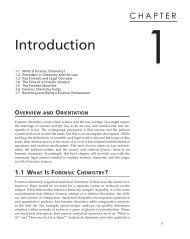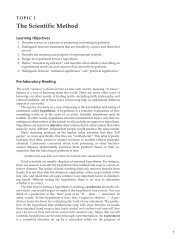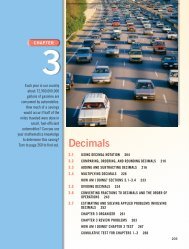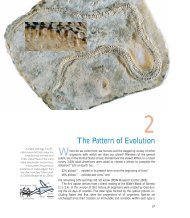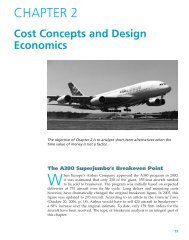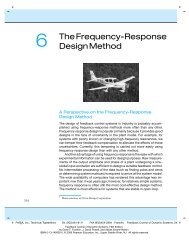CHAPTER 3 - Educators
CHAPTER 3 - Educators
CHAPTER 3 - Educators
You also want an ePaper? Increase the reach of your titles
YUMPU automatically turns print PDFs into web optimized ePapers that Google loves.
76 <strong>CHAPTER</strong> 3/COST-ESTIMATION TECHNIQUES<br />
As shown in Figure 3-2, the integrated approach begins with a description<br />
of the project in terms of a WBS. WBS is used to describe the project and each<br />
alternative’s unique characteristics in terms of design, labor, material requirements,<br />
and so on. Then these variations in design, resource requirements, and other<br />
characteristics are reflected in the estimated future costs and revenues (net cash<br />
flow) for that alternative.<br />
To estimate future costs and revenues for an alternative, the perspective<br />
(viewpoint) of the cash flow must be established and an estimating baseline and<br />
analysis period defined. Normally, cash flows are developed from the owner’s<br />
viewpoint. The net cash flow for an alternative represents what is estimated to<br />
happen to future revenues and costs from the perspective being used. Therefore, the<br />
estimated changes in revenues and costs associated with an alternative have to be<br />
relative to a baseline that is consistently used for all the alternatives being compared.<br />
3.2.1 The Work Breakdown Structure (WBS)<br />
The first basic component in an integrated approach to developing cash flows<br />
is the work breakdown structure (WBS). The WBS is a basic tool in project<br />
management and is a vital aid in an engineering economy study. The WBS serves<br />
as a framework for defining all project work elements and their interrelationships,<br />
collecting and organizing information, developing relevant cost and revenue data,<br />
and integrating project management activities.<br />
Figure 3-3 shows a diagram of a typical four-level WBS. It is developed from<br />
the top (project level) down in successive levels of detail. The project is divided<br />
into its major work elements (Level 2). These major elements are then divided to<br />
develop Level 3, and so on. For example, an automobile (first level of the WBS) can<br />
be divided into second-level components (or work elements) such as the chassis,<br />
drive train, and electrical system. Then each second-level component of the WBS<br />
can be subdivided further into third-level elements. The drive train, for example,<br />
can be subdivided into third-level components such as the engine, differential, and<br />
transmission. This process is continued until the desired detail in the definition<br />
and description of the project or system is achieved.<br />
Different numbering schemes may be used. The objectives of numbering are to<br />
indicate the interrelationships of the work elements in the hierarchy. The scheme<br />
illustrated in Figure 3-3 is an alphanumeric format. Another scheme often used is all<br />
numeric—Level 1: 1-0; Level 2: 1-1, 1-2, 1-3; Level 3: 1-1-1, 1-1-2, 1-2-1, 1-2-2, 1-3-1,<br />
1-3-2; and so on (i.e., similar to the organization of this book). Usually, the level is<br />
equal (except for Level 1) to the number of characters indicating the work element.<br />
Other characteristics of a project WBS are as follows:<br />
1. Both functional (e.g., planning) and physical (e.g., foundation) work elements<br />
are included in it:<br />
(a) Typical functional work elements are logistical support, project<br />
management, marketing, engineering, and systems integration.<br />
(b) Physical work elements are the parts that make up a structure, product,<br />
piece of equipment, or similar item; they require labor, materials, and other<br />
resources to produce or construct.



